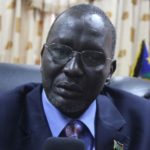Defence Minister Adolf Mwesige has disputed a government-owned report which revealed that more Ugandans are dipping into poverty with the number of poor people rising to 10 million in 2016/17, up from 6.6 million in 2012/13.
“I live in this country and I know that poverty levels have come down,” Mwesige said as he responded to a question as to why government was rushing to delete Article 102(b) of the Constitution instead of addressing social and economic challenges like poverty.
Mwesige was appearing on a night television programme discussing the current age limit circus that has put the ruling NRM party on spotlight.
Minister Mwesige’s counterpart, the state minister for finance, David Bahati concurred with the report’s authors, saying that it was not surprising that poverty levels had gone up given the economic slowdown in the country. He said government would intervene through intensification of irrigation to support agriculture in the countryside, among other measures aimed at bringing poverty levels down.
Meanwhile, when Eagleonline sought for comments from statisticians at the Uganda Bureau of Statistics (Ubos) in response to minister Mwesige’s assertion, one of the officials at the agency said: “We are professionals and we stand by the report. The minister is a politician and obviously he has to portray a positive image of the poverty situation. But the truth is that when you go deep into Uganda, some households don’t have what to eat,” the source said.
“When we publish such research reports we help politicians to allocate resources to critical areas such as fighting poverty. We see no value in us not telling the truth on the ground. It doesn’t help when we tell lies. Ours is to help politicians and policy makers come with strategies to address socio-economic challenges that the country faces,” another one said.
Ubos-a government department that manages national statistics, carried out the survey that came up with that figure which showed that poverty levels, despite government interventions over the recent past, rose to 27 percent in 2016/17 from 19.7 percent in 2012/13. Currently, Uganda’s population is estimated at 41 million people. Irony is that government wants all these people to enjoy middle income status by 2020, a target that some analysts say wont to be achieved given the current economic hardships.
According to the report dubbed the ‘National Household Survey 2016/17’, those who are hit by poverty are a fraction of Ugandans whose personal income lies below the poverty line, which stands at US1.25 (about 4500) a day. According to economists, that proportion of people lack access to basic needs, particularly, they cannot afford three meals a day.
Mr James Muwonge, the Ubos director of social economic surveys, while presenting the findings said poverty hit the eastern region most at 42 percent. He said the number of poor people in both rural and urban areas of that region increased to 4.2 million from 2.4 million. The northern region had a reduction as the number of poor people reduced to 2.4 million from 3.1 million.
Muwonge attributed the high poverty levels in eastern region to the prolonged drought, sharp increases in the prices of goods and services, animal diseases, pests, storms, floods and power outages.
Other analysts say Uganda’s increasing poverty levels can be attributed to the growth domestic product (GDP) which has been slowing down, reducing from 4.8 percent in financial year 2015/16 to 3.9 percent in 2016/17 and is expected to finish at 5 percent in 2017/18. GDP is the total value of goods and services produced domestically in a given period.







